Hitchcockella baronii is a species of bamboo, the only known species of the genus Hitchcockella. It is found in Madagascar and was first described by Aimée Antoinette Camus in 1925.
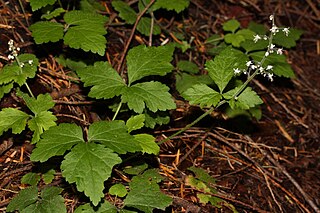
Tiarella trifoliata, the three-leaf foamflower, is a species of flowering plant in the family Saxifragaceae. The specific name trifoliata means "having three leaflets", a characteristic of two of the three recognized varieties. Also known as the laceflower or sugar-scoop, the species is found in shaded, moist woods in western North America.
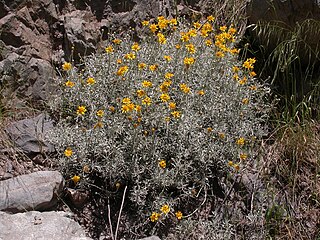
Senecio chilensis is a species of the genus Senecio, family Asteraceae and one of the many species of Senecio native to Chile.
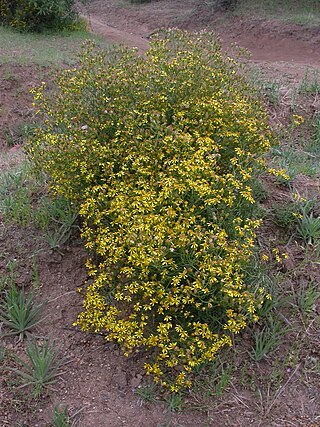
Senecio invalidus is a species of the genus Senecio and family Asteraceae.

Curio archeri, syn. Senecio toxotis is a species of succulent plant in the family Asteraceae that is indigenous to the south-western Cape, South Africa.

Salvia indica is a species of herbaceous perennial plant belonging to the family Lamiaceae. It is native to a wide region of Western Asia that includes Israel, Iraq, Iran and Turkey. It was first described by the taxonomist Carl Linnaeus in 1753. It is unknown why he gave it the specific epithet indica, since the plant is not from India. While Salvia indica is classified as a herbaceous perennial, in cultivation individual plants often live no longer than two years.
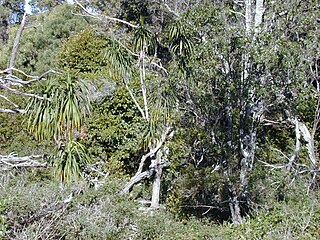
Dracaena aurea, the golden hala pepe, is a species of flowering plant that is endemic to the island of Kauaʻi in Hawaii. It inhabits coastal mesic and mixed mesic forests at elevations of 120–1,070 m (390–3,510 ft). It is a small evergreen tree, usually 4.6–7.6 m (15–25 ft) tall, but sometimes reaches 12 m (39 ft). The gray, straight trunk does not have bark and is 0.3–0.9 m (0.98–2.95 ft) in diameter. The sword-shaped leaves are 20–51 cm (7.9–20.1 in) long and 1–3 cm (0.39–1.18 in) wide.

Strelitzia caudata, commonly known as the mountain strelitzia or wild banana, is a species of banana-like Strelitzia from Africa from the Chimanimani Mountains of Zimbabwe south to Mozambique, the Northern Provinces of South Africa and Eswatini (Swaziland). It was first described in 1946 by Robert Allen Dyer in Flowering Plants of Africa, Volume 25, Plate 997. The specific epithet caudata means "having a tail"; this refers to an appendage of a sepal, which occurs only in this species. It is one of three large banana-like Strelitzia species, all of which are native to southern Africa, the other two being S. alba and S. nicolai.

Orbexilum, commonly called leather-root, is a genus of flowering plants in the legume family (Fabaceae). They are native to North America, where they are found in the United States and Mexico, south to Chiapas.

Chrysogonum is a genus of flowering plants in the family Asteraceae. As of May 2024, two circumscriptions of the genus were in use. In the broader circumscription, the genus has a discontinuous distribution, with species native to eastern North America and Madagascar. In the narrower circumscription, the genus contains only species native to eastern North America.

Euphronia is a genus of three species of shrubs native to northern South America and is the only genus in the family Euphroniaceae. It was previously classified in the Vochysiaceae family and elsewhere due to its unique floral features, but the APG III system of 2009 recognized Euphroniaceae as distinct and placed Euphronia in it. Based on molecular data from the rbcL gene, it is sister to the Chrysobalanaceae.

Chenopodiastrum is a genus of herbaceous flowering plants in the family Amaranthaceae. The genus was formally described in 2012. The 5 species occur in Eurasia, North Africa, and North America.

Symphyotrichum oolentangiense, commonly known as skyblue aster and azure aster, is a species of flowering plant in the family Asteraceae native to eastern North America.

Desmodium glabellum is a species of flowering plant in the legume family Fabaceae. It is native to the eastern and central United States. It is commonly called Dillenius' tick-trefoil in honor of Johann Dillenius, a British botanist of German birth. It is also known as the tall tick-trefoil.

Sanrobertia is a genus of flowering plants within the subtribe Symphyotrichinae of the family Asteraceae. It is monotypic, meaning there is only one species within the genus. Sanrobertia gypsophila is a rare endemic known only from Nuevo León, Mexico.
Johan Hermans is a British botanist specialising in orchids, and an Honorary Research Associate of Royal Botanic Gardens, Kew. His The Orchids of Madagascar, described as "a now classic work", was published in a second edition in 2007.

Acilepis ornata is a species of plant native to India. The species was first described by William Alexander Talbot in 1898 as Vernonia ornata.

Kimnachia is a monotypic genus of cacti. Its only species is Kimnachia ramulosa, synonym Pseudorhipsalis ramulosa, which is native from southern Mexico to northern South America and also found in Jamaica.
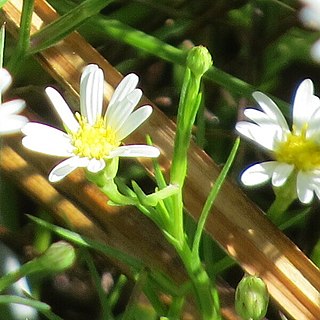
Symphyotrichum potosinum is a species of flowering plant in the family Asteraceae native to Mexico and the U.S. state of Arizona. Commonly known as Santa Rita Mountain aster, it is a perennial, herbaceous plant that may reach heights of 15 to 45 centimeters.
Jalantzia caudata is a species of flowering plant in the family Asteraceae, native to Madagascar. It was first described in 1899 as Vernonia caudata. It has also been known as Vernoniopsis caudata, but the genus VernoniopsisHumbert is an illegitimate name.
















